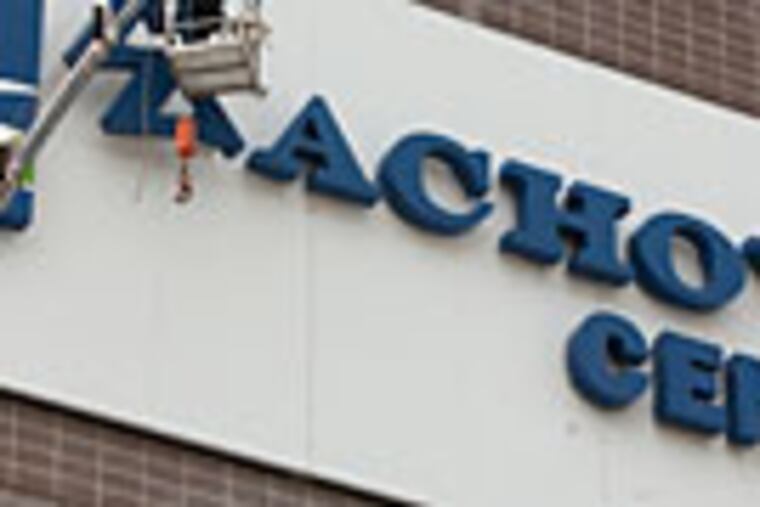PhillyDeals: Sixers-Flyers arena gets a new name - again
Halfway into a 29-year, $40 million naming-rights deal, the South Philly arena that's home to the NBA Sixers, NHL Flyers, and a lot of high-priced pop-music shows is getting its fourth new name.

Halfway into a 29-year, $40 million naming-rights deal, the South Philly arena that's home to the NBA Sixers, NHL Flyers, and a lot of high-priced pop-music shows is getting its fourth new name.
The 21,000-seat auditorium, formerly named after the vanished CoreStates, First Union, and Wachovia banks, is now the Wells Fargo Center, president Peter Luukko of owner Comcast-Spectacor said Tuesday.
What had been Wachovia is under new owners and yet another new logo, sign, and color scheme. But it's the same bank, with the biggest market share in Philadelphia, according to federal bank data.
Workers from Eastern Sign Tech, of Burlington, rose in cherry-picker buckets to lift the blue letters off the arena's green-and-blue Wachovia signs. New red-and-black Wells Fargo signs should be up by Sept. 14, when the singer Lady Gaga is scheduled to perform for a sold-out house, said Comcast-Spectacor spokesman Ike Richman.
Comcast-Spectacor "is honoring the contract that was agreed upon" with CoreStates Financial Corp. back in 1996, Luukko said in a statement. The next year, Philadelphia-based CoreStates agreed to sell itself to the former First Union Corp., which later merged with Wachovia Bank and adopted its name, until Wells Fargo took it over.
Wells Fargo & Co., an $800 billion-asset San Francisco-based company, bought the failing Wachovia two years ago, after the Charlotte, N.C., lender's own disastrous purchase of yet another bank that lent billions to people who didn't pay it back.
Wells Fargo is only now getting around to exercising its rights to rename the South Philly arena, as it prepares to slap the Wells Fargo name on more than 300 ex-Wachovia branches in Pennsylvania, Delaware, and South Jersey.
"We thought that having the signs change in time for the start of the center's new season was the most logical and most visible way to introduce the Wells Fargo brand to the region," bank spokeswoman Barbara Nate said.
Wells Fargo is a history-conscious company: It maintains horse-drawn stagecoaches used for promotions and charity events, recalling its roots as a primitive Old West transportation firm.
But the name has had little resonance in Philadelphia, which was horse-ridden in pre-automotive times, but has more recently and emphatically been associated with locomotives, helicopters, satellites, and other powerful conveyances, with modern engines, some of which are still made in the region.
Wells won't be plastering little stagecoaches on the arena's walls, Nate promised.
Despite its distant headquarters, the Wells Fargo name could prove less ephemeral than its predecessors. Wells Fargo is one of a handful of U.S. banks that are now so big, they can't be purchased by rivals, under federal bank-competition guidelines.
U.S. leads software
SAP AG said second-quarter software revenues from its Newtown Square-based Americas unit jumped 40 percent from last year, as U.S. companies resumed purchases of large systems.
SAP's numbers are proof U.S. companies "are willing to spend money on software," which is good news for Oracle and other SAP rivals, too, wrote Janney Capital Markets analyst Sasa Zorovic Ph.D., in a report to clients.
By contrast, SAP reported a 12 percent decline in Europe and a 6 percent drop in Asia, according to Goldman Sachs analyst Mohammad Moawalla. SAP co-CEO Bill McDermott blamed, in part, the euro currency crisis that inhibited spending in several major countries.
Unisys, of Blue Bell, also reported higher U.S. corporate sales, though its U.S. government sales were down after the federal Transportation Security Administration dropped Unisys for a major contract in favor of rival Computer Services Corp. Unisys has challenged TSA's decision, chief executive Ed Coleman told investors.
Asia leads industry
DuPont Co. shares rose nearly 4 percent, leading the Dow Jones industrial average slightly higher, after the Wilmington chemical, industrial-materials, and crop-seed company said it sold 21 percent more product in the second quarter of 2010, and was able to boost prices another 5 percent. That boosted total revenue to $8.6 billion, up 26 percent from the depressed spring of 2009.
Revenue from China and other Asia markets rose nearly 50 percent, while sales in the developed world rose more modestly. DuPont marked big increases in sales of solar panels and other electronics, auto paint, refrigerants, U.S. seeds, and Latin American pesticides, and cited the "continued global economic recovery."
Asked in an investors' conference call if that recovery will last, chief executive Ellen Kullman said the "tightening of credit in southern Europe" had hurt sales of construction, automotive, and farm materials. She also raised concerns of "higher rats" (material costs) cutting profit margins.
But Kullman also said DuPont was "well on its way" to topping projections of $1 billion in sales of solar-electric panels next year, doubling to $2 billion in 2014. She said the company would open its planned biofuel (cellulosic ethanol) refinery in Benore, Tenn., for commercial sales, in 2012.